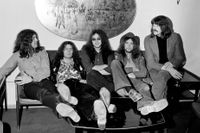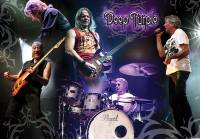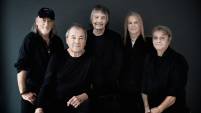Deep Purple are an English Rock band formed in Hertford in 1968. They are considered to be among the pioneers of Heavy metal and modern Hard rock, although their musical approach changed over the years. Originally formed as a Progressive rock band, the band shifted to a heavier sound in 1970. Deep Purple, together with Led Zeppelin and Black Sabbath, have been referred to as the "unholy trinity of British hard rock and heavy metal in the early to mid-seventies".
They were listed in the 1975 Guinness Book of World Records as "the globe's loudest band" for a 1972 concert at London's Rainbow Theatre, and have sold over 100 million albums worldwide.
Deep Purple have had several line-up changes and an eight-year hiatus (1976–1984). The 1968–1976 line-ups are commonly labelled Mark I, II, III and IV. Their second and most commercially successful line-up featured Ian Gillan (vocals), Jon Lord (organ), Roger Glover (bass), Ian Paice (drums), and Ritchie Blackmore (guitar). This line-up was active from 1969 to 1973, and was revived from 1984 to 1989, and again from 1992 to 1993. The band achieved more modest success in the intervening periods between 1968 and 1969 with the line-up including Rod Evans (vocals) and Nick Simper (bass, backing vocals), between 1974 and 1976 (Tommy Bolin replacing Ritchie Blackmore in 1975) with the line-up including David Coverdale (vocals) and Glenn Hughes (bass, vocals), and between 1989 and 1992 with the line-up including Joe Lynn Turner (vocals). The band's line-up (currently featuring Ian Gillan, and guitarist Steve Morse from 1994) has been much more stable in recent years, although organist Jon Lord's retirement from the band in 2002 (being succeeded by Don Airey) left Ian Paice as the only original Deep Purple member still in the band.
Deep Purple were ranked number 22 on VH1's Greatest Artists of Hard Rock programme and a poll on British radio station Planet Rock ranked them 5th among the "most influential bands ever". The band received the Legend Award at the 2008 World Music Awards. Having been nominated for the Rock and Roll Hall of Fame in 2012 and 2013 but failing to get enough votes for induction, Deep Purple were finally announced as inductees into the Hall of Fame in December 2015. They were officially inducted on 8 April 2016.
Beginnings (1967–1968)
In 1967 former The Searchers drummer Chris Curtis contacted London businessman Tony Edwards, in the hope that he would manage a new group he was putting together, to be called Roundabout. Curtis' vision was a "supergroup" where the band members would get on and off, like a musical roundabout. Impressed with the plan, Edwards agreed to finance the venture with two business partners: John Coletta and Ron Hire, all of Hire-Edwards-Coletta (HEC) Enterprises.
The first recruit to the band was the classically trained Hammond organ player Jon Lord, Curtis' flatmate who had most notably played with the Artwoods (led by Art Wood, brother of future Rolling Stones guitarist Ronnie Wood, and featuring Keef Hartley). He was followed by guitarist Ritchie Blackmore, who was persuaded to return from Hamburg to audition for the new group. Blackmore was making a name for himself as a studio session guitarist, and had also been a member of The Outlaws, Screaming Lord Sutch, and Neil Christian. Curtis' erratic behaviour and lifestyle, fueled by LSD use, caused a sudden disinterest in the project he had started, forcing HEC to dismiss him from Roundabout. But HEC was now intrigued with the possibilities Lord and Blackmore brought, while Lord and Blackmore were also keen to continue. The two carried on with recruiting additional members, keeping Tony Edwards as their manager.
For the bass guitar, Lord suggested his old friend Nick Simper, with whom he had played in a backing band for the vocal group The Flower Pot Men (formerly known as the Ivy League) in 1967. Simper had previously been in Johnny Kidd and the Pirates and survived the car crash that killed Kidd. Simper had also known Blackmore since the early 1960s when his first band, The Renegades, debuted around the same time as one of Blackmore's early bands, The Dominators. Bobby Woodman was the initial choice for the drums, but during the auditions for a singer, Rod Evans of the Maze came in with his drummer, Ian Paice. Blackmore had seen Paice on tour with the Maze in Germany in 1966, and had been impressed by the 18-year-old's drumming. While Woodman was out for cigarettes, Blackmore quickly arranged an audition for Paice. Both Paice and Evans won their respective jobs, and the line-up was complete.
The band began in earnest in March 1968 at Deeves Hall, a country house in South Mimms, Hertfordshire. The band would live, write and rehearse at Deeves Hall, which was fully kitted out with the latest Marshall amplification. After a brief tour of Denmark and Sweden in April, in which they were still billed as Roundabout, Blackmore suggested a new name: "Deep Purple", named after his grandmother's favourite song. The group had resolved to choose a name after everyone had posted one on a board in rehearsal. Second to Deep Purple was "Concrete God", which the band thought was too harsh to take on.
Early years (1968–1970)
In May 1968, the band moved into Pye Studios in London's Marble Arch to record their debut album, Shades of Deep Purple, which was released in July by American label Tetragammaton, and in September by UK label EMI. The group had success in North America with a cover of Joe South's "Hush", and by September 1968, the song had reached number 4 on the Billboard Hot 100 in the US and number 2 in the Canadian RPM charts, pushing the ShadesLP up to No. 24 on Billboard's pop album charts. The following month, Deep Purple was booked to support Cream on their Goodbye tour.
The band's second album, The Book of Taliesyn, was quickly recorded, then released in North America to coincide with the tour. The album included a cover of Neil Diamond's "Kentucky Woman", which cracked the Top 40 in both the US (#38 on the Billboard charts) and Canada (#21 on the RPM charts), though sales for the album were not as strong (#54 in US, #48 in Canada). The Book of Taliesyn would not be released in the band's home country until the following year, and like its predecessor, it failed to have much impact in the UK charts.
Early in 1969, the band recorded a single called "Emmaretta", named after Emmaretta Marks, then a cast member of the musical Hair, whom Rod Evans was trying to seduce. By March of that year, the band had completed recording for their third album, Deep Purple. The album contained strings and woodwind on one track ("April"), showcasing Jon Lord's classical antecedents such as Bach and Rimsky-Korsakov, and several other influences were in evidence, notably Vanilla Fudge. (Jon Lord and Ritchie Blackmore had even claimed the group wanted to be a "Vanilla Fudge clone".) This would be the last recording by the original line-up.
Deep Purple's troubled North American record label, Tetragrammaton, delayed production of the Deep Purple album until after the band's 1969 American tour ended. This, as well as lackluster promotion by the nearly broke label, caused the album to sell poorly, finishing well out of the Billboard Top 100. Soon after the third album's eventual release, Tetragrammaton went out of business, leaving the band with no money and an uncertain future. (Tetragrammaton's assets were assumed by Warner Bros. Records, who would release Deep Purple's records in the US throughout the 1970s.) During the 1969 American tour, Jon Lord and Ritchie Blackmore met with Ian Paice to discuss their desire to take the band in a heavier direction. Feeling that Rod Evans and Nick Simper would not fit well with a heavy rock style, both were replaced that summer. Ian Paice stated, "A change had to come. If they hadn't left, the band would have totally disintegrated." Both Nick Simper and Ritchie Blackmore noted that Rod Evans already had one foot out the door. Nick Simper said that Rod Evans had met a girl in Hollywood and had eyes on being an actor, while Ritchie Blackmore explained, "Rod just wanted to go to America and live in America."
In search of a replacement vocalist, Ritchie Blackmore set his own sights on 19-year-old singer Terry Reid. Though he found the offer "flattering", Reid was still bound by the exclusive recording contract with his producer Mickie Most and more interested in his solo career. Ritchie Blackmore had no other choice but to look elsewhere. The band hunted down singer Ian Gillan from Episode Six, a band that had released several singles in the UK without achieving their big break for commercial success. Ian Gillan had at one time been approached by Nick Simper when Deep Purple was first forming, but Gillan had reportedly told Simper that the Roundabout project would not go anywhere, while he felt Episode Six was poised to make it big. Six's drummer Mick Underwood – an old comrade of Blackmore's from his days in the Outlaws – introduced the band to Ian Gillan and bassist Roger Glover. This effectively killed Episode Six and gave Underwood a guilt complex that lasted nearly a decade, until Gillan recruited him for his new post-Purple band in the late 1970s. According to Ritchie Blackmore, Deep Purple was only interested in Ian Gillan and not Roger Glover, but Roger was retained on the advice of Ian Paice.
This created the Deep Purple Mark II line-up, whose first release was a Greenaway-Cook tune titled "Hallelujah". At the time of its recording, Nick Simper still thought he was in the band, and had called the studio to inquire about the recording dates for the song. He then found that the song had already been recorded with Roger Glover on bass. The remaining original members of Deep Purple then instructed management to inform Nick Simper that he had been officially replaced.
Despite television appearances to promote the "Hallelujah" single in the UK, the song flopped. Blackmore had told the British weekly music newspaper Record Mirror they "need to have a commercial record in Britain", and described the song as "an in-between sort of thing"—a median between what the band would normally make but with an added commercial motive.
The band gained some much-needed publicity in September 1969, with the Concerto for Group and Orchestra, a three-movement epic composed by Jon Lord as a solo project and performed by the band at the Royal Albert Hall in London with the Royal Philharmonic Orchestra, conducted by Malcolm Arnold. Together with Days of Future Passed by The Moody Blues and Five Bridges by the Nice, it was one of the first collaborations between a rock band and an orchestra. This live album became their first album with any kind of chart success in the UK. Ian Gillan and Ritchie Blackmore were less than happy at the band being tagged as "a group who played with orchestras", both feeling that the Concerto was a distraction that would get in the way of developing their desired hard-rocking style. Jon Lord acknowledged that while the band members were not keen on the project going in, at the end of the performance "you could put the five smiles together, and it would have spanned the Thames." Lord would also write the Gemini Suite, another orchestra/group collaboration in the same vein, for the band in late 1970. In 1975, Ritchie Blackmore stated that he thought the Concerto for Group and Orchestra wasn't bad but the Gemini Suite was horrible and very disjointed. Roger Glover later claimed Jon Lord had appeared to be the leader of the band in the early years.
Albums
Shades of Deep Purple (1968)
The Book of Taliesyn (1968)
Deep Purple (1969)
Deep Purple in Rock (1970)
Fireball (1971)
Machine Head (1972)
Who Do We Think We Are (1973)
Burn (1974)
Stormbringer (1974)
Come Taste the Band (1975)
Perfect Strangers (1984)
The House of Blue Light (1987)
Slaves and Masters (1990)
The Battle Rages On... (1993)
Purpendicular (1996)
Abandon (1998)
Bananas (2003)
Rapture of the Deep (2005)
Now What?! (2013)
Infinite (2017)
Whoosh! (2020)
Members
Ian Paice – drums, percussion (1968–1976, 1984–present)
Ian Gillan – vocals, harmonica, percussion (1969–1973, 1984–1989, 1992–present)
Roger Glover – bass (1969–1973, 1984–present)
Steve Morse – guitar (1994–present)
Don Airey – organ, keyboards (2002–present, touring member August 2001 – February 2002)
Former members
Jon Lord – organ, keyboards, backing vocals, string arrangements (March 1968 – March 1976, April 1984 – February 2002; died 2012)
Ritchie Blackmore – guitar (March 1968 – June 1975, April 1984 – November 1993)
Rod Evans – lead vocals (March 1968 – July 1969)
Nick Simper – bass, backing vocals (March 1968 – July 1969)
David Coverdale – lead vocals (August 1973 – March 1976)
Glenn Hughes – bass, vocals (July 1973 – March 1976)
Tommy Bolin – guitar, vocals, bass (June 1975 – March 1976; died 1976)
Joe Lynn Turner – lead vocals (December 1989 – August 1992)
Joe Satriani – guitar (touring member December 1993 – July 1994)






